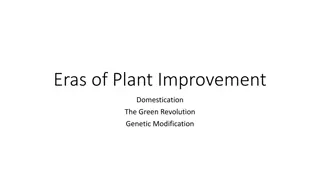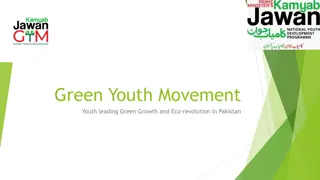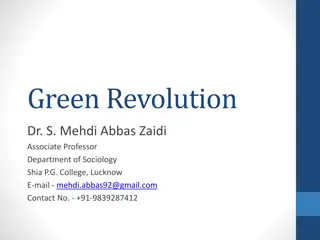
Green Revolution in India: Achievements and Impact on Agriculture
"Explore the Green Revolution in India, its introduction, impact on agricultural production, and the key figures involved like M.S. Swaminathan. Learn about the success of high-yielding variety seeds and its transformational effect on Indian agriculture."
Download Presentation

Please find below an Image/Link to download the presentation.
The content on the website is provided AS IS for your information and personal use only. It may not be sold, licensed, or shared on other websites without obtaining consent from the author. If you encounter any issues during the download, it is possible that the publisher has removed the file from their server.
You are allowed to download the files provided on this website for personal or commercial use, subject to the condition that they are used lawfully. All files are the property of their respective owners.
The content on the website is provided AS IS for your information and personal use only. It may not be sold, licensed, or shared on other websites without obtaining consent from the author.
E N D
Presentation Transcript
SeminarPpt.com Seminar on Green Revolution Submitted to: Seminarppt.com Submitted By Seminarppt.com
Table Contents Definition Introduction About Green Revolution Advantages Schemes under Green Revolution Conclusion 2
Definition The Green Revolution is referred to as the process of increasing agricultural production by incorporating modern tools and techniques. 3
Introduction Green Revolution is associated with agricultural production. It is the period when agriculture of the country was converted into an industrial system due to the adoption of modern methods and techniques like the use of high yielding variety seeds, tractors, irrigation facilities, pesticides, and fertilizers. 4
About Green Revolution The Green Revolution (a term used for rapid increases in wheat and rice yields in developing countries brought about by improved varieties combined with the expanded use of fertilizers and other chemical inputs) has had a dramatic impact on incomes and food supplies in many developing countries. The term green revolution was first used by William Gaud and Norman Borlaug is the Father of the Green Revolution. 6
About Green Revolution In the year 1965, the government of India launched the Green Revolution with the help of a geneticist, now known as the father of the Green revolution (India) M.S. Swaminathan. The movement of the green revolution was a great success and changed the country s status from a food-deficient economy to one of the world s leading agricultural nations. It started in 1967 and lasted till 1978. 7
About Green Revolution The Green Revolution within India led to an increase in agricultural production, especially in Haryana, Punjab, and Uttar Pradesh. Major milestones in this undertaking were the development of a high-yielding variety of seeds of wheat and rust-resistant strains of wheat. 8
About Green Revolution Aspects of Green Revolution in India High Yielding Varieties (HYV) Mechanization of Agriculture Use of Chemical Fertilizers and Pesticides Irrigation 9
Schemes Under Green Revolution (India) Prime Minister Narendra Modi approved the Umbrella Scheme Green Revolution Krishonnati Yojana in the agriculture sector for the period of three years from 2017 to 2020 with the Central Share of Rs. 33,269.976 crore. 11
Schemes Under Green Revolution (India) The Umbrella scheme Green revolution- Krishonnati Yojana comprises 11 Schemes under it and all these schemes look to develop the agriculture and allied sector in a scientific and holistic manner so as to increase the income of farmers by increasing productivity, production, and better returns on produce, strengthening production infrastructure, reducing the cost of production and marketing of agriculture and allied produce. 12
Schemes Under Green Revolution (India) MIDH Mission for Integrated Development of Horticulture It aims to promote the comprehensive growth of the horticulture sector, enhance the production of the sector, improve nutritional security, and increase income support to household farms 13
Schemes Under Green Revolution (India) NFSM National Food Security Mission This includes NMOOP National Mission on Oil Seeds and Oil Palm. The aim of this scheme is to increase the production of wheat pulses, rice, coarse cereals and commercial crops, productivity enhancement, and area expansion in a suitable manner, enhancing farm level economy, restoring soil fertility and productivity at the individual farm level. 14
Schemes Under Green Revolution (India) NMSA National Mission for Sustainable Agriculture The aim is to promote sustainable agriculture practices that are best suitable to the specific agro-ecology focusing on integrated farming, appropriate soil health management, and synergizing resource conservation technology. 15
Schemes Under Green Revolution (India) SMAE Submission on Agriculture Extension This scheme aims to strengthen the ongoing extension mechanism of State Governments, local bodies, etc. achieving food security and socio-economic empowerment of farmers, to forge effective linkages and synergy amongst various stakeholders, to institutionalize program planning and implementation mechanism 16
Schemes Under Green Revolution (India) SMSP Sub-Mission on Seeds and Planting Material This aims to increase the production of quality seed, upgrade the quality of farm-saved seeds and increase SRR, strengthen the seed multiplication chain, and promote new methods and technologies in seed production, processing, testing, etc., 17
Schemes Under Green Revolution (India) SMAM Sub-Mission on Agricultural Mechanisation This aims to increase the reach of farm mechanization to small and marginal farmers and to the regions where availability of farm power is low, to promote Custom Hiring Centres to offset the adverse economies of scale arising due to small landholding and high cost of individual ownership, to create hubs for hi-tech and high-value farm equipment. 18
Conclusion Around the age of 6 months, an infant's need for energy and nutrients starts to exceed what is provided by breast milk, and complementary foods are necessary to meet those needs. An infant of this age is also developmentally ready for other foods. This transition is referred to as complementary feeding. 20
References Wikipedia.org Google.com Seminarppt.com Studymafia.org






















